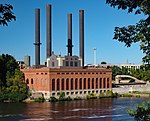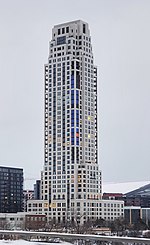I-35W Mississippi River bridge

The I-35W Mississippi River bridge (officially known as Bridge 9340) was an eight-lane, steel truss arch bridge that carried Interstate 35W across the Mississippi River one-half mile (875 m) downstream from the Saint Anthony Falls in Minneapolis, Minnesota, United States. The bridge opened in 1967 and was Minnesota's third busiest, carrying 140,000 vehicles daily. It had a catastrophic failure during the evening rush hour on August 1, 2007, killing 13 people and injuring 145. The NTSB cited a design flaw as the likely cause of the collapse, noting that a too-thin gusset plate ripped along a line of rivets, and additional weight on the bridge at the time contributed to the catastrophic failure.Help came immediately from mutual aid in the seven-county Minneapolis–Saint Paul metropolitan area and emergency response personnel, charities, and volunteers. Within a few days of the collapse, the Minnesota Department of Transportation (Mn/DOT) planned its replacement with the I-35W Saint Anthony Falls Bridge. Construction on the replacement bridge was completed quickly, with it opening on September 18, 2008.
Excerpt from the Wikipedia article I-35W Mississippi River bridge (License: CC BY-SA 3.0, Authors, Images).I-35W Mississippi River bridge
West River Parkway Trail, Minneapolis
Geographical coordinates (GPS) Address Nearby Places Show on map
Geographical coordinates (GPS)
| Latitude | Longitude |
|---|---|
| N 44.978888888889 ° | E -93.245 ° |
Address
I-35W Saint Anthony Falls Bridge
West River Parkway Trail
55454 Minneapolis
Minnesota, United States
Open on Google Maps











